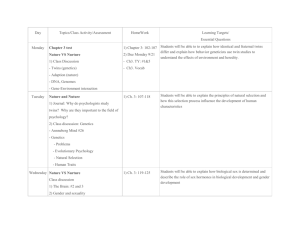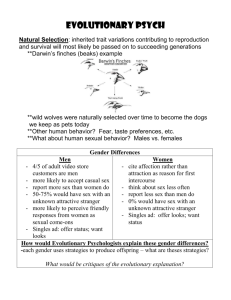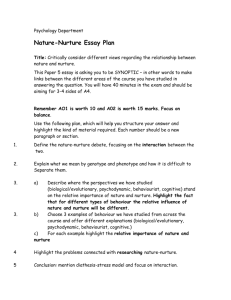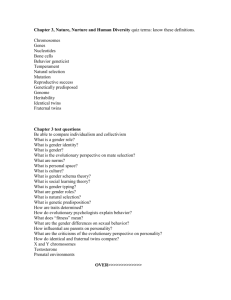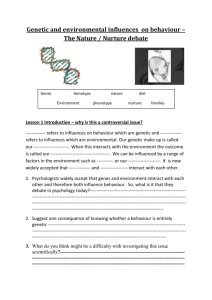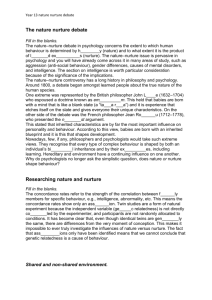Genetic and environmental influences Essay Plan
advertisement
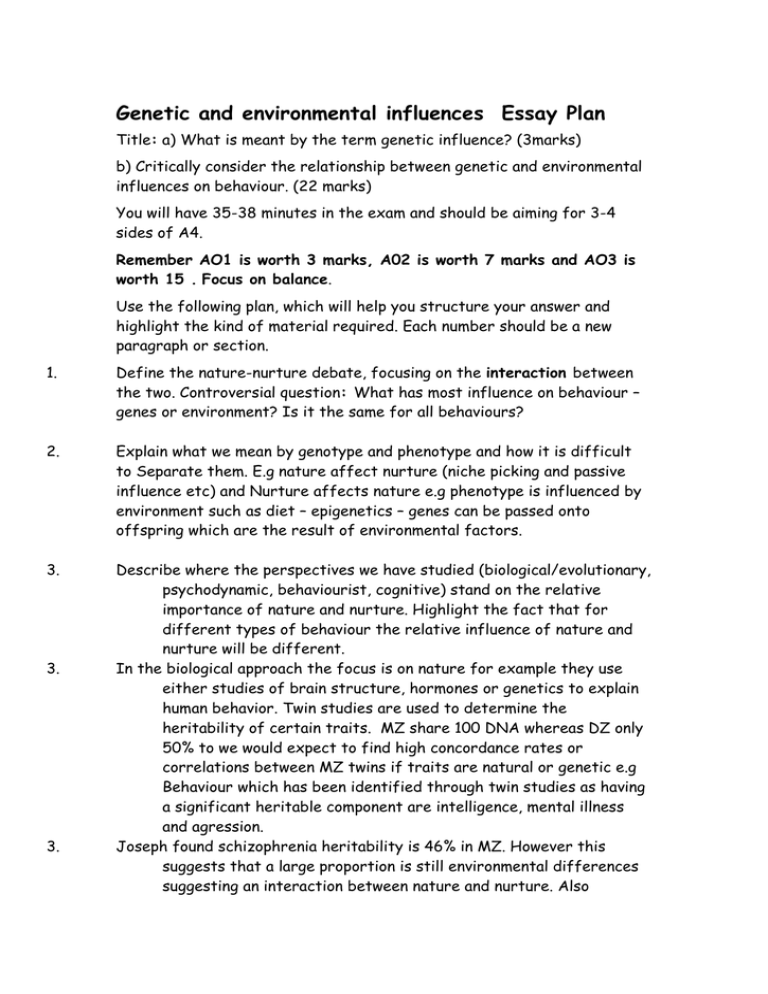
Genetic and environmental influences Essay Plan Title: a) What is meant by the term genetic influence? (3marks) b) Critically consider the relationship between genetic and environmental influences on behaviour. (22 marks) You will have 35-38 minutes in the exam and should be aiming for 3-4 sides of A4. Remember AO1 is worth 3 marks, A02 is worth 7 marks and AO3 is worth 15 . Focus on balance. Use the following plan, which will help you structure your answer and highlight the kind of material required. Each number should be a new paragraph or section. 1. Define the nature-nurture debate, focusing on the interaction between the two. Controversial question: What has most influence on behaviour – genes or environment? Is it the same for all behaviours? 2. Explain what we mean by genotype and phenotype and how it is difficult to Separate them. E.g nature affect nurture (niche picking and passive influence etc) and Nurture affects nature e.g phenotype is influenced by environment such as diet – epigenetics – genes can be passed onto offspring which are the result of environmental factors. 3. Describe where the perspectives we have studied (biological/evolutionary, psychodynamic, behaviourist, cognitive) stand on the relative importance of nature and nurture. Highlight the fact that for different types of behaviour the relative influence of nature and nurture will be different. In the biological approach the focus is on nature for example they use either studies of brain structure, hormones or genetics to explain human behavior. Twin studies are used to determine the heritability of certain traits. MZ share 100 DNA whereas DZ only 50% to we would expect to find high concordance rates or correlations between MZ twins if traits are natural or genetic e.g Behaviour which has been identified through twin studies as having a significant heritable component are intelligence, mental illness and agression. Joseph found schizophrenia heritability is 46% in MZ. However this suggests that a large proportion is still environmental differences suggesting an interaction between nature and nurture. Also 3. 3. 3. 3. 3. 3. 3. Evolutionary perspective has shown that humans share certain universal characteristics e.g Buss identified commonalities across the world in mate preferences of men and women In the Behaviourist approach the focus is on environment. They believe we can only explain behavior by observing is externally and what influences it through external stimuli. For example Watson believed that conditioning was the most important factor so for example Little Albert’s fear of rats was conditioned thorugh the environment. Bandura showed how children could learn vicariously to be aggressive. However they are ignoring the fact that we need certain innate qualities to be able to learn and seek reward etc. The cognitive approach tends to fall on the side of interaction between nature and nurture. They conduct lab experiments to find out how innate cognitive processes are determined by environmental stimuli. For example mental illness can be explained by how a person perceives events that happen to them and how they think positively or negatively e.g Beck’s cognitive triad takes into account processes which are innate and external factors. The Psychodynamic approach also take both into account for according to Freud the drives coming from the Id are basic instincts (hence biological) Whereas resolving the conflicts between Id ego and superego depend upon childhood experiences. However research has shown there are social and environmental factors which may affect all of these e.g socio-economic status affects IQ and educational attainment, stressful circumstances affect mental illness - Diathesis Stress Model – explain. and aggression can be affected by role models. This means that whilst the biological and behaviourist approaches seem to favour either nature or nuture the other favour interaction leaving the question of which is more important unanswered in Psychology. 4 Furthermore it is notoriously difficult to study genetic and environmental influences because people who share genetic material usually share environments as well, explain problems with studying twins, adoption studies, family studies. Can be solved by using separated twins or comparing adopted to biological family but these are problematic as well. 5 Conclusion: Come to the conclusion that nature/nurture is difficult to study scientifically and isolate variables, and that most psychologists agree that there is interaction between the two - mention diathesis-stress model and focus on interaction.
